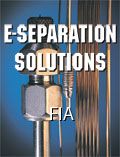The LCGC Blog: Flow Injection Analysis Can Be Used to Create Temporal Compositional Analyte Gradients for Mass Spectrometry-Based Quantitative Analysis
E-Separation Solutions
Flow injection analysis (FIA) is a powerful technique for quantitative analysis, especially in conjunction with mass spectrometry (MS) detection. Kevin Schug discusses how FIA can be combined with MS using electrospray ionization and describes how the technique can be used for analytes such as binding constant determination, multipoint instrument response calibrations, and removing the dependence of measured analyze concentrations on matrix effects.
After taking a month off (or two, if you count my ramblings about zombies in October [1] to be less than useful), I felt I needed to present something especially interesting to contemplate. Several recent activities have prompted my desire to discuss the topic of flow injection analysis (FIA), and I have not addressed it yet this year in my blog posts because it is quite unconventional in the sense of traditional chromatography with mass spectrometry (MS) detection. Some recent FIA research has been brought to my attention and I have had some related grant-writing activities (my main excuse for my hiatus last month), which have compelled me to finally write a bit about the merits of the technique. FIA is by no means a new concept (2), but surprisingly little work has been performed combining FIA (in the traditional context) with MS detection (3). What I mean by “traditional context” is that we are not simply considering a direct injection or direct infusion experiment to make some basic MS measurements. Instead, FIA refers more to a network of pumps, injectors, reactor elements, and detectors connected appropriately to enable on-line continuous flow analysis of an analyte based on reproducible dispersion, mixing, and reaction conditions. Since the mid-1970s, analytical scientists have used FIA to develop novel and efficient means to accomplish atomic analysis (4), titrations (5,6), enzyme–substrate reactions (7), and much more (8). FIA manifolds can range from a simple series of components to a complex network of hardware incorporating multiple interconnected pumping, mixing, reaction, and detection systems. Early work in FIA set the stage for contemporary lab-on-a-chip, lab-on-a-valve, and micro total analysis systems.
Since beginning my independent career at UT Arlington, I have worked on the combination of FIA and MS (9). We have been primarily concerned with increasing the throughput of electrospray ionization (ESI) MS noncovalent binding determinations to aid drug discovery in conjunction with combinatorial libraries or natural product extracts. The soft ionization nature of the ESI process allows noncovalent complexes formed in solution to be transferred intact into the gas phase. A major advantage of using FIA for quantitative determination of binding constants is that a full multipoint titration can be performed from a single injection in a matter of minutes; in an off-line multiple injection format, such an analysis typically would require hours to complete. This concept of a static titration (multiple individual vials) versus a dynamic titration (via FIA) is shown schematically in Figure 1. In general, it should be understood that the use of MS for measuring binding constants is far from routine. The potential influence of the ESI shrinking-droplet process on the host–guest equilibrium of interest must be considered (10), but that is a topic for another post. It is also important to note that the use of MS detection for FIA-based binding determinations is not compulsory, but it does simplify the ability to delineate signals for the different equilibrium species.
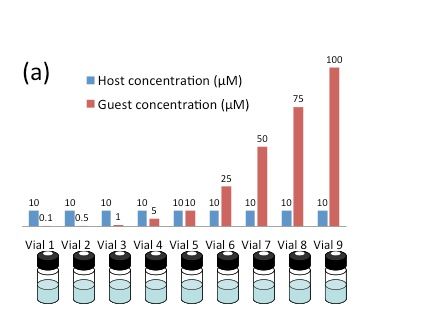
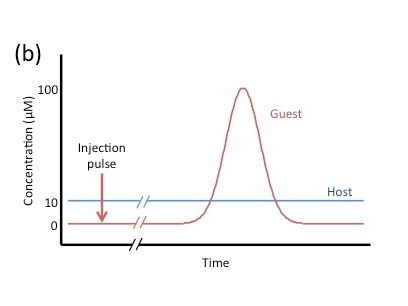
In a traditional “static” titration (Figure 1a), a series of vials with constant concentration of host and varying concentration of guest are prepared. These can be sequentially injected in a series of analytical runs. Conversely, a “dynamic” titration (Figure 1b) creates a temporal compositional gradient of the guest compound in the presence of a constant concentration of host. A discrete plug of guest is pulse injected into the FIA manifold and allowed to band-broaden over time. A complete multipoint titration experiment is completed in a single injection.
Although there are many possibilities for FIA experimental design, one way that binding constants can be determined is by titrating a constant flow of a host molecule with an injected and band-broadened guest profile. As in Figure 1b, titration is performed if the guest is band-broadened in the presence of a constant concentration of host. An increase in the concentration of guest with time occurs on the front of the peak and a decrease in the concentration of guest with time occurs on the back of the peak . Early on, we developed a modified Gaussian function that could be combined with simple equilibrium binding models to fit such curves and extract binding constants from measured complex ion intensities (11). This is fine for simple systems, but it is not amenable for multiplexing determinations; and if the band-broadened profile is asymmetrical, then use of the Gaussian function will introduce significant error in the determination. To improve this situation, we developed a model with which generated titration profiles can be directly integrated to determine single or multiplexed determinations (12). In fact, the integration model we developed could handle an infinite number of overlapping competing binding phenomena, but of course we would eventually be limited by how many systems could be measured at once without ion suppression or overlap of ion signals in the ESI mass spectra. In one embodiment, we showed how the binding of chromatographically separated amino acid enantiomers to chiral selectors could be directly determined through postcolumn addition of the selector in an enhanced throughput format (13).
Although so many complex determinations can be accomplished using FIA, and these can be extended to MS detection for determinations such as those discussed above, the elegance and utility of FIA can be demonstrated in some more simplistic manifestations. The fact that a single injection can be band-broadened to create a temporal compositional gradient means that multipoint calibrations of instrument response can be accomplished in one shot. Figure 2 illustrates this concept. The primary consideration is to have an appropriate mathematical function that can be used to convert time points to concentration points. In a study our group performed several years ago, we were interested in deriving models to correlate ESI response to physicochemical properties of some simple tripeptides. It became convenient to measure response factors (technically, the slopes of calibration curves, as shown in Figure 2c) using a single-injection FIA format (14). We derived a simple Gaussian function that could precisely return response factors for our analytes, which had been band-broadened into nicely symmetrical curves. Incidentally, it is certainly possible to consider the use of a polynomial-modified Gaussian function to accommodate asymmetrical curves.

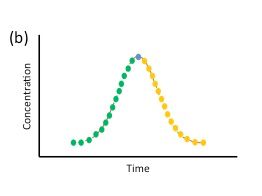

I mentioned that some new research was recently brought to my attention. I was very happy to read and consider an approach published this month by Nanita in Analytical Chemistry (15). In an elegant fashion, Nanita showed that FIA could be used in conjunction with ESI-MS-MS to remove the dependence of measured analyte concentrations on matrix effects. It is well known that quantitative analysis using ESI-MS, typically in conjunction with liquid chromatography, is fraught with difficulties arising from consideration of how matrix species that are coeluted with the analyte of interest can change analyte ion response. I have written about these difficulties in a previous blog post (16). It is also well understood that the magnitude of matrix effects are concentration dependent. That is, a higher concentration of matrix components (think coeluted lipids from a serum sample) typically increases the matrix effect (usually, suppression of analyte ion response). Similarly, dilution of the matrix typically lessens the effect. Nanita was able to derive a model and show that by using FIA to dilute an analyte in the presence of a matrix (that is, in an actual sample), the acquired data could be reconstructed to extrapolate back and determine the original concentration of the analyte. To say this another way, the sample containing the analyte (and matrix) is injected into the FIA manifold. The ESI-MS-MS system is set to monitor an analyte-specific fragment ion transition to achieve selective detection. As the sample band is band-broadened, initially a very dilute and then increasingly concentrated solution enters the ESI source. After the peak maximum passes, the analyte band then undergoes an additional dilution on the tail of the peak. Somewhere along the “wings” of the band-broadened sample band, sufficient dilution of matrix components is achieved and the analyte exhibits matrix-free response. Using the analyte ion response recorded in the limit of dilute solution, such data can be deconvoluted, mathematically transformed, and replotted to extrapolate back to reveal the initial analyte concentration. Figure 3 seeks to summarize this concept. Nanita went on to show how different transformations of the data were appropriate depending on the severity of the matrix interferences. Very nice accuracy and precision was shown for a variety of analytes (for example, hexazinone and sulfonylurea herbicides) in a variety of matrices (for example, corn meal, rat urine, canola seed, and whole rat blood). I have certainly tried to simplify the concept here for the sake of brevity, but if you are interested, I hope you will obtain a copy of the article so that you can appreciate the subtle intricacies of this excellent work.
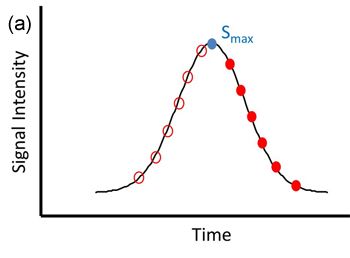
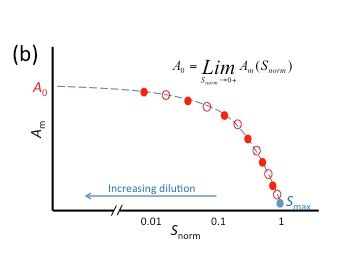
I think that FIA is a very powerful technique for quantitative analysis, especially in conjunction with MS detection, and that is underappreciated. I am not one to advocate the complete removal of chromatography in favor of using MS to resolve all of the necessary components, but there are times where this is possible. Nanita has nicely shown a way that matrix effects can be circumvented and this is perhaps one of the most difficult aspects of quantitative MS with which we have to deal. I hope that this blog entry gives you some pause to consider how FIA might be used in novel ways. Certainly, simplicity and amenability for increased throughput are compelling advantages.
References
(1) K.A. Schug, The LCGC Blog. October 7, 2013. http://www.chromatographyonline.com/lcgc/Blog/The-LCGC-Blog-What-to-Do-if-Zombies-Infiltrate-the/ArticleStandard/Article/detail/824685?contextCategoryId=50130.
(2) J. Ruzicka and E. Hansen, Anal. Chim. Acta78, 145–157 (1975).
(3) H. Fan and K.A. Schug, Current Trends in Mass Spectrometry, supplement to LCGC North Am., 26-33 (May 2012).
(4) S. Olsen, L.C.R. Pessenda, J. Ruzicka, and E.H. Hansen, Analyst108, 905–917 (1983).
(5) W. Blaedel and R. Lasseig, Anal. Chem.37, 332–336 (1965).
(6) K. Dong and P. Dasgupta, Talanta70, 131–137 (2003).
(7) J.-W. Choi, K.W. Oh, J.H. Thomas, W.R. Heineman, H.B. Halsall, J.H. Nevin, A.J. Helmicki, H.T. Henderson, and C.H. Ahn, Lab on a Chip2, 27–30 (2002).
(8) J. Ruzicka, Trends Anal. Chem.17, 69–73 (1998).
(9) K.A. Schug, C.A. Serrano, and P. Fryčák, Mass Spectrom. Rev.29, 806–829 (2010).
(10) K.A. Schug, “Practical Investigation of Molecular and Biomolecular Noncovalent Recognition Processes in Solution by ESI-MS,” in Reactive Intermediates: MS Investigations in Solution, L.S. Santos, Ed. (Wiley-VCH Verlag GmbH & Co. KGaA, Weinheim. 2010), pp. 277–305.
(11) P. Fryčák and K.A. Schug, Anal. Chem.79, 5407–5413 (2007).
(12) P. Fryčák and K.A. Schug, Anal. Chem.80, 1385–1393 (2008).
(13) P. Fryčák and K.A. Schug, Chirality21, 929–936 (2009).
(14) M.A. Raji, C. Temiyasathit, S.B. Kim, G. Mavromaras, J.-M. Ahn, and K.A. Schug, Rapid Commun. Mass Spectrom.23, 2221–2232 (2009).
(15) S.C. Nanita, Anal. Chem. ASAP (dx.doi.org/10.1021/ac402567w).
(16) K.A. Schug, The LCGC Blog. March 13, 2013. http://www.chromatographyonline.com/lcgc/Blog/The-LCGC-Blog-Do-Not-Forget-to-Assess-Potential-Ma/ArticleStandard/Article/detail/808000?contextCategoryId=42339?topic=114
Previous blog entries from Kevin Schug:
The LCGC Blog: What to Do if Zombies Infiltrate the Analytical Laboratory: A Brief Survival Guide
The LCGC Blog: From HPLC to LC-MS-Mobile-Phase Composition is the Main Consideration
The LCGC Blog: An Excel Tutorial for Modeling Chromatographic Separations
The LCGC Blog: A Closer Look at Temperature Programming in Gas Chromatography
The LCGC Blog: Back to Basics: The Role of Thermodynamics in Chromatographic Separations
The LCGC Blog: The Dimensionality of Separations: Mass Spectrometry Is Separation Science
The LCGC Blog: What Can Analytical Chemists Do for Chemical Oceanographers, and Vice Versa?
The LCGC Blog: Historical (Analytical) Chemistry Landmarks
November 1st 2024The American Chemical Society’s National Historic Chemical Landmarks program highlights sites and people that are important to the field of chemistry. How are analytical chemistry and separation science recognized within this program?

.png&w=3840&q=75)

.png&w=3840&q=75)



.png&w=3840&q=75)



.png&w=3840&q=75)
